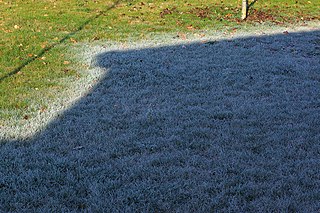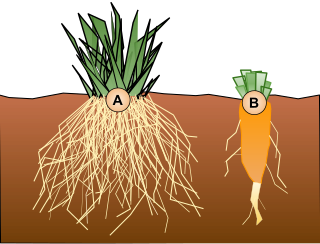
Taiga, also known as boreal forest or snow forest, is a biome characterized by coniferous forests consisting mostly of pines, spruces, and larches.
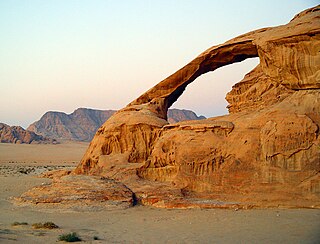
Weathering is the breaking down of rocks, soil, and minerals as well as wood and artificial materials through contact with the Earth's atmosphere, water, and biological organisms. Weathering occurs in situ, that is, in the same place, with little or no movement, and thus should not be confused with erosion, which involves the movement of rocks and minerals by agents such as water, ice, snow, wind, waves and gravity and then being transported and deposited in other locations.

In geology, permafrost is ground, including rock or (cryotic) soil, at or below the freezing point of water 0 °C (32 °F) for two or more years. Most permafrost is located in high latitudes, but at lower latitudes alpine permafrost occurs at higher elevations. Ground ice is not always present, as may be in the case of non-porous bedrock, but it frequently occurs and it may be in amounts exceeding the potential hydraulic saturation of the ground material. Permafrost accounts for 0.022% of total water on Earth and the permafrost region covers 24% of exposed land in the Northern Hemisphere. It also occurs subsea on the continental shelves of the continents surrounding the Arctic Ocean, portions of which were exposed during the last glacial period.

Alpine tundra is a type of natural region or biome that does not contain trees because it is at high elevation. As the latitude of a location approaches the poles, the threshold elevation for alpine tundra gets lower until it reaches sea level, and alpine tundra merges with polar tundra.

The tree line is the edge of the habitat at which trees are capable of growing. It is found at high elevations and high latitudes. Beyond the tree line, trees cannot tolerate the environmental conditions. The tree line is sometimes distinguished from a lower timberline or forest line, which is the line below which trees form a forest with a closed canopy.

Scree is a collection of broken rock fragments at the base of crags, mountain cliffs, volcanoes or valley shoulders that has accumulated through periodic rockfall from adjacent cliff faces. Landforms associated with these materials are often called talus deposits. Talus deposits typically have a concave upwards form, while the maximum inclination corresponds to the angle of repose of the mean debris size.

Alpine plants are plants that grow in an alpine climate, which occurs at high elevation and above the tree line. There are many different plant species and taxon that grow as a plant community in these alpine tundra. These include perennial grasses, sedges, forbs, cushion plants, mosses, and lichens. Alpine plants are adapted to the harsh conditions of the alpine environment, which include low temperatures, dryness, ultraviolet radiation, and a short growing season.

Silene acaulis, known as moss campion or cushion pink, is a small mountain-dwelling wildflower that is common all over the high arctic and tundra in the higher mountains of Eurasia and North America,. It is an evergreen perennial.

Páramo can refer to a variety of alpine tundra ecosystems. Some ecologists describe the páramo broadly as "all high, tropical, montane vegetation above the continuous timberline". A more narrow term classifies the páramo according to its regional placement in the northern Andes of South America and adjacent southern Central America. The páramo is the ecosystem of the regions above the continuous forest line, yet below the permanent snowline. It is a "Neotropical high mountain biome with a vegetation composed mainly of giant rosette plants, shrubs and grasses". According to scientists, páramos may be "evolutionary hot spots" and among the fastest evolving regions on Earth.

Bear Rocks are a widely recognized symbol of West Virginia wilderness and among the most frequently photographed places in the state. They are a well-known landmark on the eastern edge of the plateau that includes the Dolly Sods Wilderness. They sit in a high-elevation heathland punctuated with wind-carved sandstone outcrops and is home to more than a dozen rare plant and animal species. Situated on the crest of the Allegheny Front, Bear Rocks afford vistas over the South Branch Potomac River. Visibility can extend eastward to the Shenandoah National Park in Virginia.
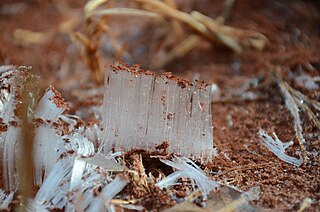
Needle ice is a phenomenon that occurs when the temperature of the soil is above 0 °C (32 °F) and the surface temperature of the air is below 0 °C (32 °F). The subterranean liquid water is brought to the surface via capillary action, where it freezes and contributes to a growing needle-like ice column.

Feldmark, also spelt fjaeldmark, is a plant community characteristic of sites where plant growth is severely restricted by extremes of cold and exposure to wind, typical of alpine tundra and subantarctic environments.
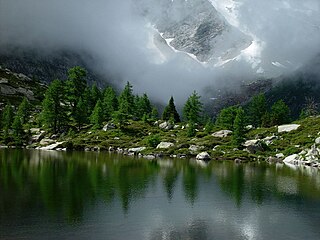
Montane ecosystems refers to any ecosystem found in mountains. These ecosystems are strongly affected by climate, which gets colder as elevation increases. They are stratified according to elevation. Dense forests are common at moderate elevations. However, as the elevation increases, the climate becomes harsher, and the plant community transitions to grasslands or tundra.

Saxifraga bryoides is a species of saxifrage known by the common name of mossy saxifrage. In German it is known as Moosartiger Steinbrech. It is an inhabitant of the Arctic tundra but it also grows in the Alps and other European mountain ranges at high altitudes.
Draba exunguiculata is a species of flowering plant in the mustard family known by the common names clawless draba and Grays Peak draba. It is endemic to Colorado in the United States.
Alpine vegetation refers to the zone of vegetation between the altitudinal limit for tree growth and the nival zone. Alpine zones in Tasmania can be difficult to classify owing to Tasmania's maritime climate limiting snow lie to short periods and the presence of a tree line that is not clearly defined.

The flora of the U.S. Sierra Nevada alpine zone is characterized by small, low growing, cushion and mat forming plants that can survive the harsh conditions in the high-altitude alpine zone above the timber line. These flora often occur in alpine fell-fields. The Sierra Nevada alpine zone lacks a dominant plant species that characterizes it, so may or may not be called a vegetation type. But it is found above the subalpine forest, which is the highest in a succession of recognized vegetation types at increasing elevations.
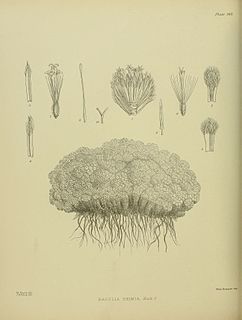
Raoulia eximia is a species of plant in the aster family. It was first formally described in 1864 by Joseph Dalton Hooker. It is endemic to New Zealand. The plant is commonly known by its Māori name tutāhuna and as the true vegetable sheep, suggesting its appearance at a distance resembling a sheep.



